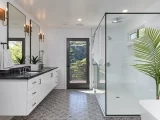
Transform Floors With Stencils and Paint
June 17, 2024Stencil it and paint it on that ugly laundry or mudroom floor! Stenciling floors isn’t easy, so you might want someone to help you: many stencils have registration marks on them.
Load your roller with as much paint as you can without it oozing, then roll over the stencil, lightly. If you apply too much pressure, the stencil may seep and bleed under the stencil, which is why you should always press lightly to prevent running.
Tile Stencils
Tile stencils are made for painting or staining your floor tiles to create a beautiful backdrop for your furnishing pieces. These beautiful tile stencil designs can help you match your decor theme.
Start by surface preparation for stencilling 1. Remove old base coat paint and sand to remove roughs spots. Now you are ready to resand and apply your fresh base sheen coat paint. We recommend that you use either a 1/4”-3/8” tight nap roller or a dense foam roller for best results.
Be sure to cover the edges of your baseboard in low tack painter’s tape before you stencil so that you can safely and easily remove it without paint damage after you are finished. With your brush loaded with your French Blue Acrylic Paint Mix, dab on the tile blotting (also referred to as Capillo) the excess paint on a folded paper towel, using pouce with varying pressure to create a look of aged and glazed tile.
Wood Stencils
Using stain to stencil designs on your wood floors produces a simple, elegant look that can be accomplished in a day or weekend for much less than wallpaper or new carpeting, and can be painted over if you change your mind or decide you don’t like it.
If you are stencilling with paint, you want to avoid bleeding – that is, paint seeping under and around the edges of your stencil so that the stencil leaves a ragged or messy finish. First and foremost, you can keep this from happening by preparing your stencil surface well: sand if the surface feels rough; otherwise, clean it carefully before you start!
Before you start painting, it’s a good idea to apply a barrier coat of decoupage or mod podge. This will seal out wood grooves so that no paint will bleed into them and then back into their grooves. Use a roller brush because it provides an even coverage of paint across its entire surface.
Vinyl Stencils
Vinyl stencil applications are a great solution especially to clients who want wood designs to be temporary. Because these are single use stencil applications, our vinyl stickers are the perfect solution.
Look the other way, it is perfectly suitable for flat surfaces, but it also takes readily to curvy surfaces, not to the extreme, but to a place where the surface starts to curve. For this, stencil vinyl has low-tack adhesive and a paper look and feel to it, so you can paint stencils with it. That’s right…paint stencils.
However, one feature of vinyl stencils that excites us is their unlimited versatility in applications. As an example, we stencilled an old piece of vinyl flooring with a Grecian Tile Damask pattern. Painted with a 3″ stencil brush, fully loaded with pink mix of Antoinette + Emperor’s Silk (to help prevent paint bleed), we first primed and cleaned according to manufacturer’s directions.
Metal Stencils
Metal stencils are the best option when it comes to painting symbols on a car park, creating a company logo or decorating a high-level graphic. Not only they are great in terms of quality, durability and prices; you can use them repeatedly!
If we’re stencilling a floor it is a good idea to spray two stencils so that an extra one is cut if required for tight spots and edges. If things are going wrong we should stop and touch up the mess with a paint brush.
Stencil on metal requires more input than onto other surfaces but the process remains largely the same. When using caked paint (also known as caked paint), take extra care that your stencil is being regularly cleaned off – a light scrub with some soap and warm water should do the trick.






